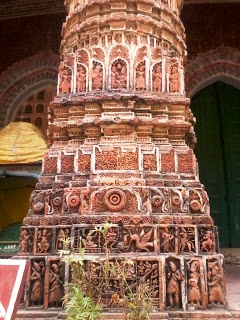The terracotta decoration of Kantaji temple is simply outstanding, its wall surface from the base to the crest of its three stories, both inside and out, pulsates with an amazing profusion of figured and floral art in unbroken succession.
The vast array of subject matter include the stories of the Mahabharata (Mahabharat) and the Ramayana (Ramayan), the exploits of Krishna, and a series of extremely fascinating contemporary social scenes depicting the favorite pastimes of the landed aristocracy.
Mythological legend in terracotta of Kantaji temple (Kantaji Mandir): The astonishing profusion, delicacy of modeling, and the beauty of its carefully integrated friezes has seldom been surpassed by any mural art of its kind in Bengal. However, even in its bewildering abundance of diverse motifs, one can observe a carefully arranged thematic scheme in the composition of subject matters at different levels and spaces on the temple wall.
In general pattern of terracotta decoration of the temple's outer walls, the lowest four basal panels, running parallel across the four faces, depict from bottom upward, immediately above the plinth: (a) a recurring floral motif, consisting of full-blown rosettes alternated with a four-foiled foliate pattern; (b) the second frieze portrays contemporary social scenes and the hunting parties of the landed nobility; (c) the third parallel panel above depicts an intricately designed series of full-blown rosettes commonly found on earlier Sultanate mosques such as at the Shat Gombuj mosque, Bagha mosque, Kusumba mosque, Chhota Sona mosque etc.
A Royal procession scene in terracotta, Kantaji Temple The second register depicts animated hunting scenes of wild games, royal processions of elephants, horses, camels, and dainty ox-carts of the nobility with their retainers in Mughal dress and arms.
The richly caparisoned majestic elephants and splendid stallions, their chariot and harness are vividly delineated; corpulent Zamindars are seen squatting in their gilded palanquins puffing from luxurious Hukkas with long sinuous pipes. Still, other panels portray river cruises on long slim boats crowded with revelers; squads of soldiers often wearing European dress are also shown marching with drawn swords and even muskets.
The richly caparisoned majestic elephants and splendid stallions, their chariot and harness are vividly delineated; corpulent Zamindars are seen squatting in their gilded palanquins puffing from luxurious Hukkas with long sinuous pipes. Still, other panels portray river cruises on long slim boats crowded with revelers; squads of soldiers often wearing European dress are also shown marching with drawn swords and even muskets.
Mythological scenes on the third register depict the nativity of Krsna (Krishna); the demon King Kangsa; successive attempts to kill the infant Krsna; Krsna's killing of the Putana ogress and the Bakasura or crane-demon; the lifting of Govardhana mountain, the killing of Keshi; the quelling of the snake-demon, Kaliya, and Krsna's pleasure ride on a long slim boat with revellers. The south face of the temple also presents stories from the Ramayana in a somewhat confused sequence.
Ramayana stories continue on the east face. Here the exile of Ramachandra, Sita, and Laksmana in the Panchavati forest; Laksmana's striking off the nose of Shurpanakha; the abduction of Sita by Ravana from Dandakaranya; Jatayu's futile attempt to obstruct the chariot of Ravana; the captivity of Sita in Ashoka Forest; the fight between Bali and Sugriva with their monkey followers for the throne of Kiskindhya; Ramachandra's sapta tala veda and Sugriva with his monkey followers and their palaver with Ramachandra are shown in striking details.
A hunting scene in terracotta, Kantaji Mandir The north face predominantly portrays scenes of Krishna and Balarama. Thus Krishna's various marriages and cowgirls carrying milk and curd pots in shika (string bags) suspended from pole etc are shown.
In the second register, an interesting European battleship is depicted in great details with soldiers and a cannon. The entire western face of the third register depicts various episodes from the Krishna legend, ending in the slaying of Kangsa, the demon king of Mathura.
It includes the annihilation of Kuvalayapida, the monstrous killer elephant of Kangsa; and Radha's fainting fits on her failing to dissuade Krsna from participating in Kangsa's sports tournament in Mathura.
Of particular interest is a group of cowherds carrying milk and butter in string bags, suspended from a pole on the shoulder, which is still a familiar scene in rural Bengal. The elaborate panels over the spandrels of multi-cusped arches exhibit animated battle scenes from the great epics and also rasa-mandala, with dancing Radha-Krsna couple within circles, and a host of accessory figures.
The spirited battle scenes of Kurukshetra and Lanka are depicted with great vitality and invention by the folk artists. The mythological legend in terracotta, Kantaji Temple In the seemingly inexhaustible store of terracotta mural decoration on the temple wall, the folk artists, mostly from Krishnanagar, often have left behind the imprint of their keen awareness of the environment in which they lived.
The deities they depicted in panels were sometimes treated with an astonishing sense of reality and as intimate and familiar members of their society. For instance, an extremely interesting series of upright western panels on the bottom register of the western face depicts Krsna plucking coconut from the tree and handing them over to one of his companions climbing halfway up the trunk, who, in turn, is delivering these to another companion waiting on the ground.
It is a familiar scene in Bengal where the deity is intimately shown as one of the members of society. Individual plaques often display idiosyncratic compositions such as the one found on the inner face of the corridor on the south face where Radha-Krishna are shown dancing on an elephant very cleverly composed of a dozen human figures.
Again, on the northern face, Krishna is depicted with one of his newly wedded bride seated on a pidi (low wooden stool) under a canopy where she is coyly holding her veil with one hand over her head and bashfully peeping at her lord.
This, of course, is an endearing familiar wedding scene in rural Bengal. In the bewildering crowd of friezes, one may even find Krishna squatting nonchalantly with folded knees, tied with a gamchha (a strip of cloth) around the knees and back, in a posture altogether uncommon among Bengalis, but common among the working classes in adjacent Bihar. However, one distinctly delightful aspect of the fabulous terracotta ornamentation of the Kantaji Temple (Kantaji Mandir) is its restraint in depicting erotic scenes. In this, it is unlike Orissan and South Indian temples.
Dancing female |





















I think the intricacy of the artwork is amazing and the history behind it is fascinating.
ReplyDeleteI just love this post! there is so much work in this artwork it is just amazing!
ReplyDeleteInteresting article! Learned quite alot
ReplyDeleteSo beautiful and informative!
ReplyDeleteOh wow the details on these statues are incredible! How long does it take to make one?
ReplyDeleteInformative article with loads of beautiful pictures. Fascinating share of history.
ReplyDeleteThere is so much detail in this temple and in your post! You did a great job describing all of the elements and explaining their history and significance. Thank you!
ReplyDeleteThanks for the informative post. I actually read a lot about the dancing female.
ReplyDeleteI really love looking at Terracotta made things, it's so intricate and intimate. I also wonder how long it took to make those decorations on the Kantaji temple? I wish that dedication to work was more present through our time.
ReplyDeleteMost architecture and designs from the past are absolutely brilliant. Looks like people took their art seriously during the time.
ReplyDeleteOh the art! It's so beautiful 😍
ReplyDeleteThat is really beautiful. I would love go visit the temple one day.
ReplyDeleteThe temple is interesting. Love how you closed-up to it, shared the design. I think all detailed design have stories to it.
ReplyDeleteAmazing place I also visit there I loved that place .... Creativity is so amazing
ReplyDeleteWow the details are mind blowing. Thanks for sharing
ReplyDeleteThe art decorations amazingly depicts the lifestyle of the rich culture in the past. Nice post. ❤
ReplyDeleteThank you for introducing me to this piece of art. You description was very detailed and informative. I enjoy learning about artwork. One of my favorite classed in college was art history.
ReplyDeletei love history its ancient time amazing info with value able images thanks for sharing.
ReplyDeleteThe detail work is incredible! I feel like you could spend a week there looking at the artwork and still not see all the intricacies.
ReplyDeleteThe detail is incredible! I feel like you could look for a lifetime and still not see all the intricacies.
ReplyDeleteGreat post! Amazing pictures and very informative!
ReplyDeleteit's interesting the amount of knowledge you can get from intricate pieces of art. thanks for sharing
ReplyDeleteIt is so incredible to see the intricate details in the sculptures and figures. They are truly made so well - they've withstood the ultimate test of time! Thank you for sharing this info and the wonderful photos.
ReplyDeleteI love visiting places with such rich histories. The stories in these carvings are amazing, i can't wait to go enjoy them in person
ReplyDeletewow, very pretty! Thanks! The pics are amazing and lots of info for sure!
ReplyDeleteThank you for sharing! I learned something new today. The pictures are amazing!
ReplyDelete-Nicole V
I find the detailing breathtaking even now but to think about how many years ago this was created its mind-blowing.
ReplyDeleteInteresting, these carvings look so beautiful. SO intrinsic work , loved every bit of the photos and post!
ReplyDeleteI love visiting places with such rich histories. These art pieces are amazing.
ReplyDeleteI love the scenes with the animals in them. They look so real and accurate. I can't imagine how long it took to make some of those pieces!
ReplyDeleteWhat lovely design steeped in history. I've always been intrigued by ancient Indian cultures.
ReplyDeleteThis comment has been removed by a blog administrator.
ReplyDeleteThe details and artistry shown in these photos is incredible. It always amazes me how ancient cultures were so advanced with their incredible sculpture techniques
ReplyDeleteI like all the little details it makes it so much more better.
ReplyDeleteI didnt even know Bangladesh had so many exciting sites! definitely adding to our list of must visit countries!
ReplyDeleteI would love to see the terracotta pieces in person some day. I have learned about some of the stories of Krishna but not seen these.
ReplyDeleteOk. I must confess that I have never heard about all of this. It is interesting to read through it and understand the history behind it all.
ReplyDeleteAs a draftswoman, I highly enjoyed this article. Art will never die! :D
ReplyDeleteThese are really cool. I'm in awe seeing these Terracotta earthware still exist. Thanks for sharing.
ReplyDeleteFrom: Calleigh Keibler - theForkbite